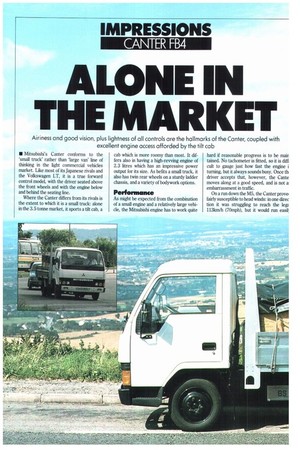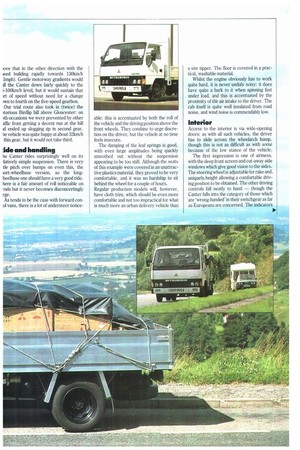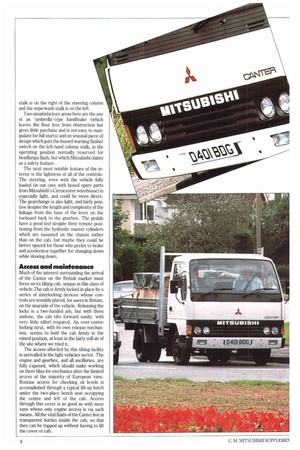ALONE IN
Page 186

Page 187

Page 188

If you've noticed an error in this article please click here to report it so we can fix it.
THE MARKET Airiness and good vision, plus lightness of all controls are the hallmarks of the Canter, coupled with excellent engine access afforded by the tilt cab
• Mitsubishi's Canter conforms to the 'small truck' rather than 'large van' line of thinking in the light commercial vehicles market. Like most of its Japanese rivals and the Volkswagen LT, it is a true forward control model, with the driver seated above the front wheels and with the engine below and behind the seating line.
Where the Canter differs from its rivals is the extent to which it is a small truck: alone in the 3.5 tonne market, it sports a tilt cab, a cab which is more roomy than most. It differs also in having a high-revving engine of 2.3 litres which has an impressive power output for its size. As befits a small truck, it also has twin rear wheels on a sturdy ladder chassis, and a variety of bodywork options.
Performance
As might be expected from the combination of a small engine and a relatively large vehicle, the Mitsubishi engine has to work quite hard if reasonable progress is to be main tamed. No tachometer is fitted, so it is diffi cult to gauge just how fast the engine i turning, but it always sounds busy. Once th, driver accepts that, however, the Cante moves along at a good speed, and is not a embarrassment in traffic.
On a run down the M5, the Canter prove, fairly susceptible to head winds: in one direc tion it was struggling to reach the leg2 11312m/h (70mph), but it would run easil; love that in the other direction with the leed building rapidly towards 130km/h lmph). Gentle motorway gradients would ill the Canter down fairly quickly to the i-100km/h level, but it would sustain that Irt of speed without need for a change iwn to fourth on the five-speed gearbox. Our trial route also took in (twice) the itorious Birdlip hill above Gloucester: on ith occasions we were prevented by other affic from getting a decent run at the hill id ended up slogging up in second gear. he vehicle was quite happy at about 32km/h this gear, but it would not take third.
ide and handling
he Canter rides surprisingly well on its latively simple suspension. There is very tie pitch over bumps on even this, the loft-wheelbase version, so the longheelbase one should have a very good ride. here is a fair amount of roll noticeable on mds but it never becomes disconcertingly rge.
As tends to be the case with forward conol vans, there is a lot of tuidersteer notice
able: this is accentuated by both the roll of the vehicle and the driving position above the front wheels. They combine to urge discretion on the driver, but the vehicle at no time feels insecure.
The damping of the leaf springs is good, with even large amplitudes being quickly smoothed out without the suspension appearing to be too stiff. Although the seats of this example were covered in an unattractive plastics material, they proved to be very comfortable, and it was no hardship to sit behind the wheel for a couple of hours.
Regular production models will, however, have cloth trim, which should be even more comfortable and not too impractical for what is much more an urban delivery vehicle than
a site tipper. The floor is covered in a practical, washable material.
Whilst the engine obviously has to work quite hard, it is never unduly noisy: it does have quite a bark to it when spinning fast under load, and this is accentuated by the proximity of the air intake to the driver. The cab itself is quite well insulated from road noise, and wind noise is commendably low.
Interior
Access to the interior is via wide-opening doors: as with all such vehicles, the driver has to slide across the wheelarch hump, though this is not as difficult as with some because of the low stance of the vehicle.
The first impression is one of airiness, with the deep front screen and cut-away side windows which give good vision to the sides. The steering wheel is adjustable for rake and, uniquely, height allowing a comfortable driving position to be obtained. The other driving controls fall neatly to hand — though the Canter fails into the category of those which are 'wrong-handed' in their switchgear as far as Europeans are concerned. The indicators
stalk is on the right of the steering column and the wipe/wash stalk is on the left.
Two unsatisfactory areas here are the use of an umbrella'-type handbrake (which leaves the floor free from obstruction but gives little purchase and is not easy to manipulate for hill starts) and an unusual piece of design which puts the hazard warning flasher switch on the left-hand column stalk, in the operating position normally reserved for headlamps flash, but which Mitsubishi claims as a safety feature.
The next most notable feature of the interior is the lightness of all of the controls. The steering, even with the vehicle fully loaded (in our case with boxed spare parts from Mitsubishi's Cirencester warehouse) is especially light, and could be more direct. The gearchange is also light, and fairly positive despite the length and complexity of the linkage from the base of the lever on the toeboard back to the gearbox. The pedals have a good feel despite their remote positioning from the hydraulic master cylinders which are mounted on the chassis rather than on the cab, but maybe they could be better spaced for those who prefer to brake and accelerator together for changing down while slowing down.
Access and maintenance
Much of the interest surrounding the arrival of the Canter on the British market must focus on its tilting cab, unique in this class of vehicle.The cab is firmly locked in place by a series of interlocking devices whose controls are sensibly placed, for users in Britain, on the nearside of the vehicle. Releasing the locks is a two-handed job, but with them undone, the cab tilts forward easily, with very little effort required. An over-centre locking strut, with its own release mechanism, seems to hold the cab firmly in the raised position, at least in the fairly still air of the site where we tried it_ The access afforded by this tilting facility is unrivalled in the light vehicles sector. The engine and gearbox, and all ancillaries, are fully exposed, which should make working on them bliss for mechanics after the limited access of the majority of European vans. Routine access for checking oil levels is accomplished through a typical lift-up hatch under the two-place bench seat occupying the centre and left of the cab. Access through this cover is as good as with most vans whose only engine access is via such means. All the vital fluids of the Canter live in transparent bottles inside the cab, so that they can be topped up without having to lift the cover or cab.
































































































































































































